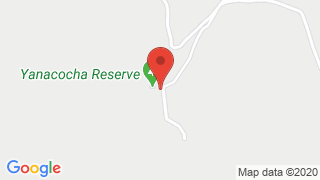Ecological Reserve Yanacocha


Yanacocha
Private Reserve manages the Foundation Jocotoco, covers 1200 hectares, surrounded by a matrix of agricultural land with remnants of mature forest, which are located towards the summit acantiladosy lines pulled off the crags of the Pichincha volcano. And it is the main habitat of the Black - breasted Puffleg (Eriocnemis nigrivestis), emblematic bird of Quito since 2005. Andean Condor, Andean Bear, wolf moorland puma, among others. Reserve is responsible for protecting wildlife especially birds like the hummingbird, caracara curiquingue very threatened that inhabits the area between 3200-3400 m. In 2005 breasted Puffleg was declared "Ave Emblematic of the Metropolitan District of Quito" by Resolution of the Metropolitan Council.
Yanacocha Hours: 7:00 to 15:30
Yanacocha How to get there?
Location: Reserva Yanacocha
It is located in the upper western slopes behind the Volcano Guagua Pichincha Quito, nearby, in the rural parish of Nono, in the province of Pichincha.
Old road to Nono, Ecoroute walk Quinde km 10. Turn left and continue 8 km. Instalacionnes EPMAPS 2km crossing over.
Biological Reserve Yanacocha
The area has provided water to the north of Quito for over 100 years. Visit the reserve includes the crossing of cultures where you can watch birds permanently live here too the Tinamú Piquicurvo. The driveway consists of high Andean forests. There are some stations hummingbird drinking fountains in various parts of the trail, offering very close sightings of many species.
Home to a huge diversity of birds, amphibiams, reptiles and mammals returning to this place a destination visited by domestic and foreign tourists
There is more than half of the species (amphibians in its entirety) is endemic to North Andes of Ecuador and southern Colombia, and include terrestrial frogs Pristimantis curtipes, Pristimantis leoni and Pristimantis unistrigatus. Two species are endemic to the Andes of Ecuador, and include a terrestrial frog (Pristimantis sp. Nov.). And a minadora lizard (Riama unicolor).
The conservation status of 60% of the species of amphibians and reptiles have registered 60% of conservation, with exception of seatpost lagartija leafminer (Riama unicolor) which is in danger of extinction.
The reserve Yanacocha preserves the sanctuary for several species of hummingbirds
To the west of the Pichincha volcano, two thousand meters above sea level is a paradise they inhabit different types of these small birds.
The climate of Quito, early in the morning is cold, like any other day. At that time, with Luis Astudillo (photographer) we started the tour in a jeep Land Rover of the year 68 on the road to Nono, northwest of Quito, to the Reserve Yanacocha.
The city is behind and continue the road to the west of the Pichincha volcano. The road is winding and large ditches mud. While we climbed the 3,200 meters above sea level you can see on the right and left the Ecuadorian paramo and cattle grazing. The capital is reduced after us.
A route that takes one hour and thirty minutes pair reaches the reserve, park the car at the entrance of a resort that has an area 960 hectares. And the cost of entry is $ 3 national tourists.
A narrow path higher degree of difficulty, but you can observe the flora of the place and the way you can observe ferns, bromeliads, orchids and other plant species, where small insects alight and also carry out the process pollination, water can additionally hear and see small streams that travel through the rocks.
You reach the last refuge called "Black-Breasted Puffleg" the landscape becomes another picture. In the wetland, hummingbirds are free and fly near one.
These small birds pass quickly near the ear or behind our backs; for speed not you can see them, but feel them. Luis takes his camera and as his last wish asks photograph Hummingbird Pico Espada, which then become our karma.
Luis hiccupped appears suddenly in charge of booking. Reaches the site with a water bottle and putting liquid into a water troughs colibríes. He tells us that from 07:00 until 15:00 booking is open.
Hummingbirds stand in the troughs as posing. His big eyes, long thin beak. Their colorful feathers electric colours petrify visitors and displayed as a melodic orchestra. Contrails blue, green, black and yellow are while flapping and absorb water.
The most common hummingbird is the place breasted Puffleg, emblematic bird of Quito, considered endangered by deforestation and climate change.
Neblinaae expands and increases cold, but the big hummingbird that my partner wants to photograph does not appear. On site we have almost two and a half hours. "Only two seconds," he says, because a few minutes before could not immortalize in a photo for your quick presence.
At forty-five minutes bird appears and it is still as wanting to be photographed. Its beak is longer than its body and measures 10 centimetres.
After reaching the picture we withdraw from the place and behind us, hummingbirds flit.

Publicado en:
Publicado por:




